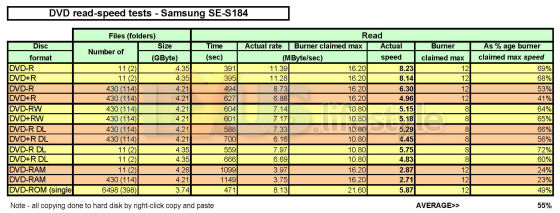Real-world results - DVD
DVD write-speed results
As you can see from the first table of results below, the Samsung's claimed write speeds for different types of DVD media are considerably at odds with our real-world findings.
Okay, there were situations - as we've explained in our notes on pages eight and nine - where the blank media we used was not rated as fast as the Samsung's maximum burn speed. However, the results show that burns aren't even as fast as the media's claimed maximum and in many cases are half that or less.
The main reason for the discrepancy, we believe, is the simple fact that when a maker of burners claims a particular speed, it's not actually claiming that speed at all - once you look at the small print.
Contrary to what you might reasonably assume, what's not being claimed is that the top burn speed is maintained throughout the writing process - only that it is reached at some point during the process!
You may have noticed that the table on page three listing the Samsung's claimed write/read speeds also shows that the burner employs two different write-speed strategies for DVD.
One, CAV (constant angular velocity), is used with DVD+R, DVD-R and DVD-RAM. The other, Z-CLV (zoned constant linear velocity), is used with DVD+/-RW and DVD+/-R DL.
CAV is so-called because the disc - spinning at a fixed rotational speed - travels through a constant angle in any given amount of time. With CAV, the effective write speed increases as the laser moves from the centre of the disc towards the edge, the distance travelled by the outer part of the disc in any given amount of time being greater than that travelled by the inner.
DVDs, like CDs are written to - and read - from the centre outwards, so, with CAV, the burner only achieves its maximum speed in the last stages of writing.
Z-CLV is a variation of another strategy, CLV (constant linear velocity). With CLV, the burner decreases the rotational speed as the laser moves outwards from the centre of the disc, so as to ensure that the disc always passes under the laser at the same speed, irrespective of which part of the disc the laser is sitting above.
But, with Z-CLV, the speed of the disc's rotation doesn't change smoothly as the laser moves outwards - something that's incredibly difficult to do. Instead, it decreases in steps as the laser passes towards the edge of disc and into and out of different 'zones'.
Overall, though, the intended effect of Z-CLV is to maintain the speed of the disc under the laser at roughly the same level right across the disc and throughout the burn.
That explains why the best results we saw were for media burnt with a Z-CLV burning strategy.
The two Z-CLV-burnt formats that fared best were DVD-RW and DVD+RW but the other two - DVD-R DL and DVD+R DL - weren't in the same league. They did better than DVD-R and DVD+R - and a whole lot better than DVD-RAM - but were dragged down, we think, by the additional time that the software and burner take to deal with twin layers.
But DVD-R DL did less well than DVD+R DL. The reason for that, as we suggest in our notes, isn't simply because the DVD-R DL discs were rated at 4x, rather than 8x. What also had an effect, we reckon, was the long time that -R DL took to final.
We were interested in start-to-finish times, not the time that it took for data to burn. Our reasoning for measuring this way was that, in terms of real-world importance, start-to-finish times - how long burns take - are what anybody would be interested in, not some theoretical figure.
What also needs to be considered is the rounding down that Samsung and its competitors carry out to inflate capacities and speeds - as detailed on page eight - but that doesn't account for more than a percentage point or so of the discrepancy.
So, in large measure, the DVD burn speeds that Samsung claims - just like the burn speeds that others claim - are far removed from what you can expect to achieve when you carry out writing tasks yourself.
And you need to bear this in mind if high burn speeds are going to be one of the deciding factors you take into account when buying a DVD writer.
DVD read-speed results
The Samsung's read strategy - CAV (constant angular velocity) - also explains why its real-world read speeds for DVD are so much worse than the claimed headline figures.
With CAV, the maximum read speed is only achieved when the laser is getting close to the outer edge of the disc. At all other times, since the disc is spinning at a constant speed, the read speed is slower.
Of course, the rounding down that Samsung and its competitors carry out to inflate capacities and speeds is also a factor but, again, accounts for little more than a percentage point of the discrepancy.
The bottom line, though, as the table above shows, is that the Samsung's claimed read speeds falls far short of its real-world performance so, again, you need to bear this in mind when making buying decisions and using claimed read performance as part of that evaluation.
Results for CD writing and reading are on the following page...











